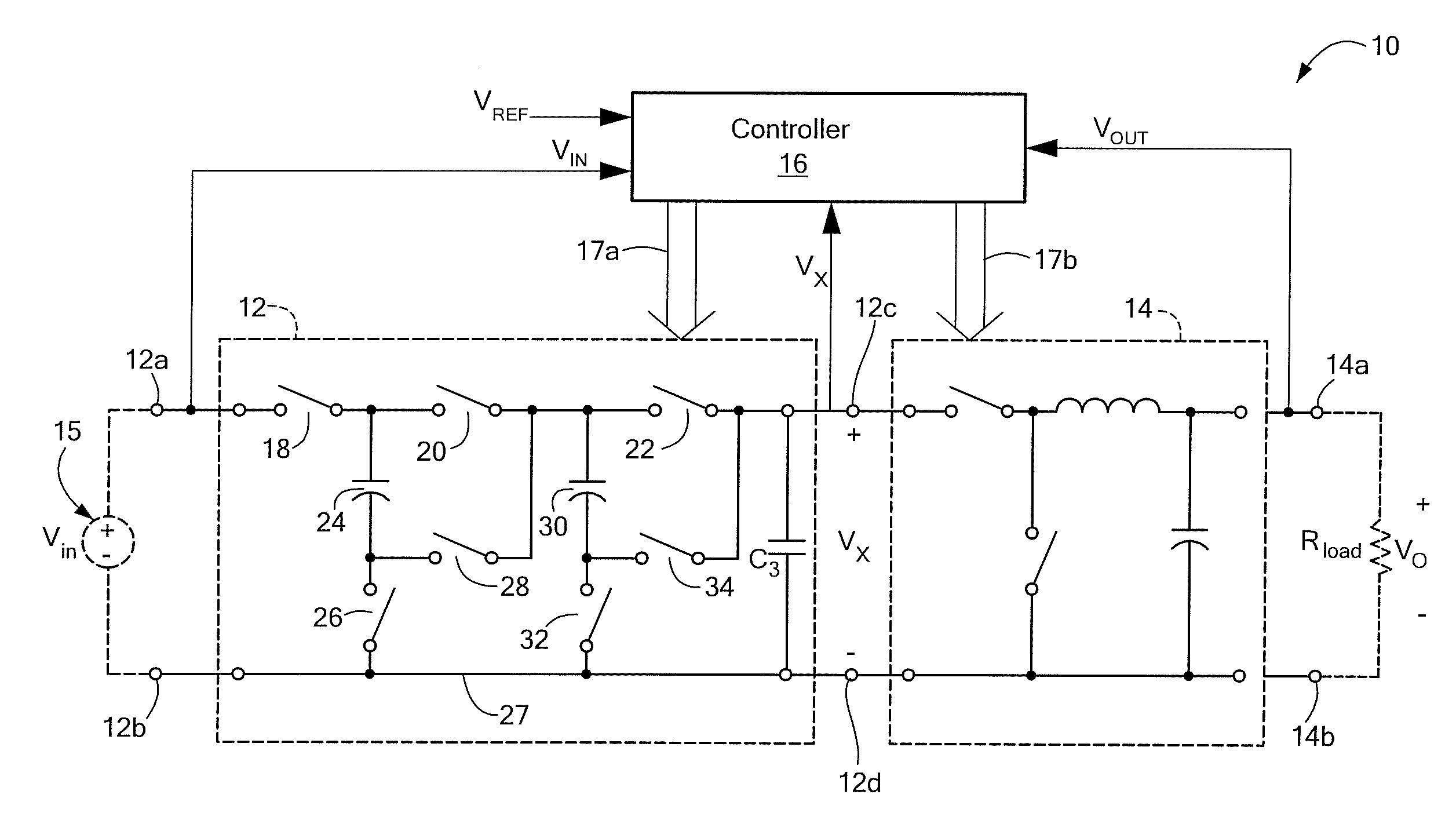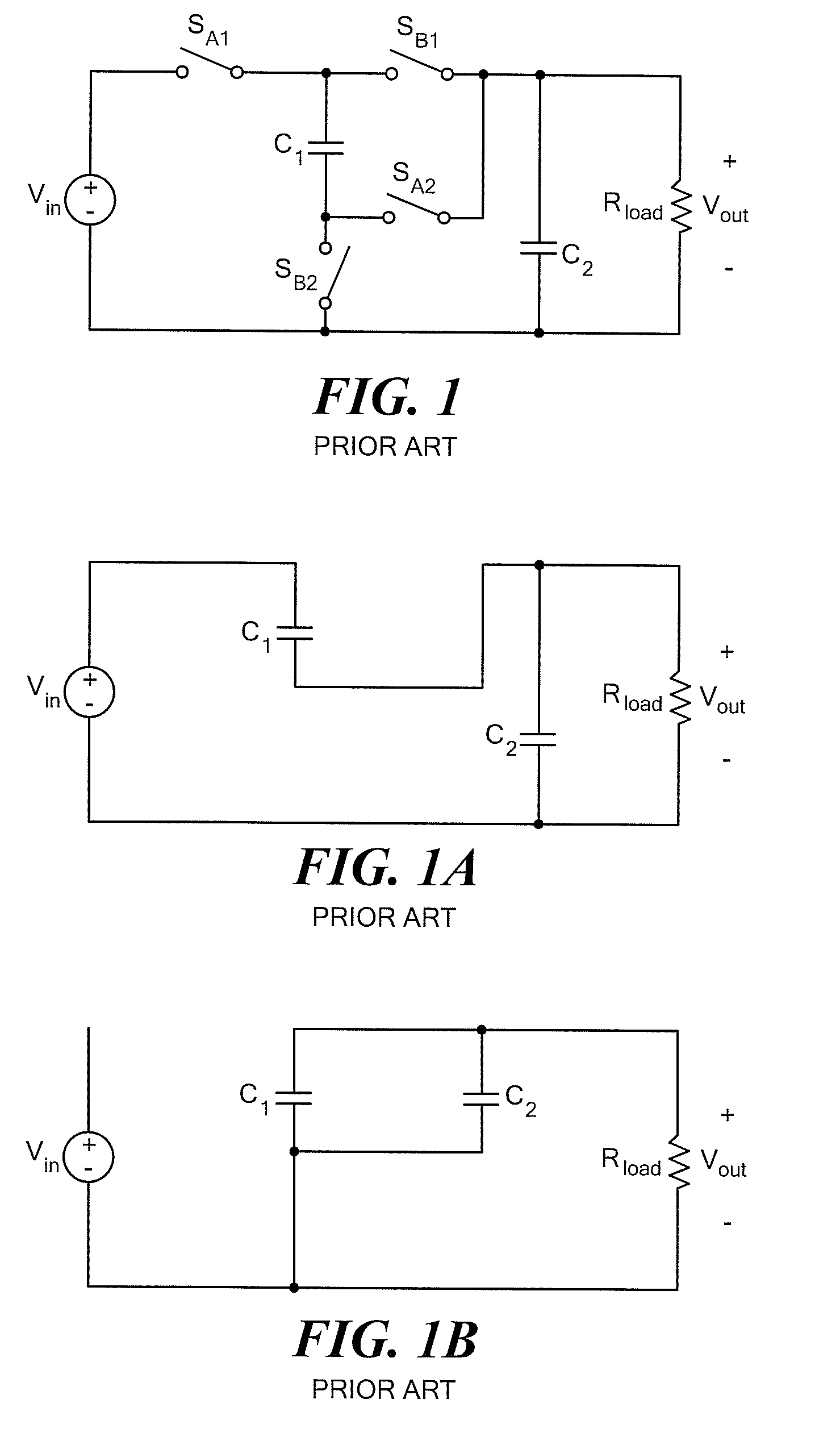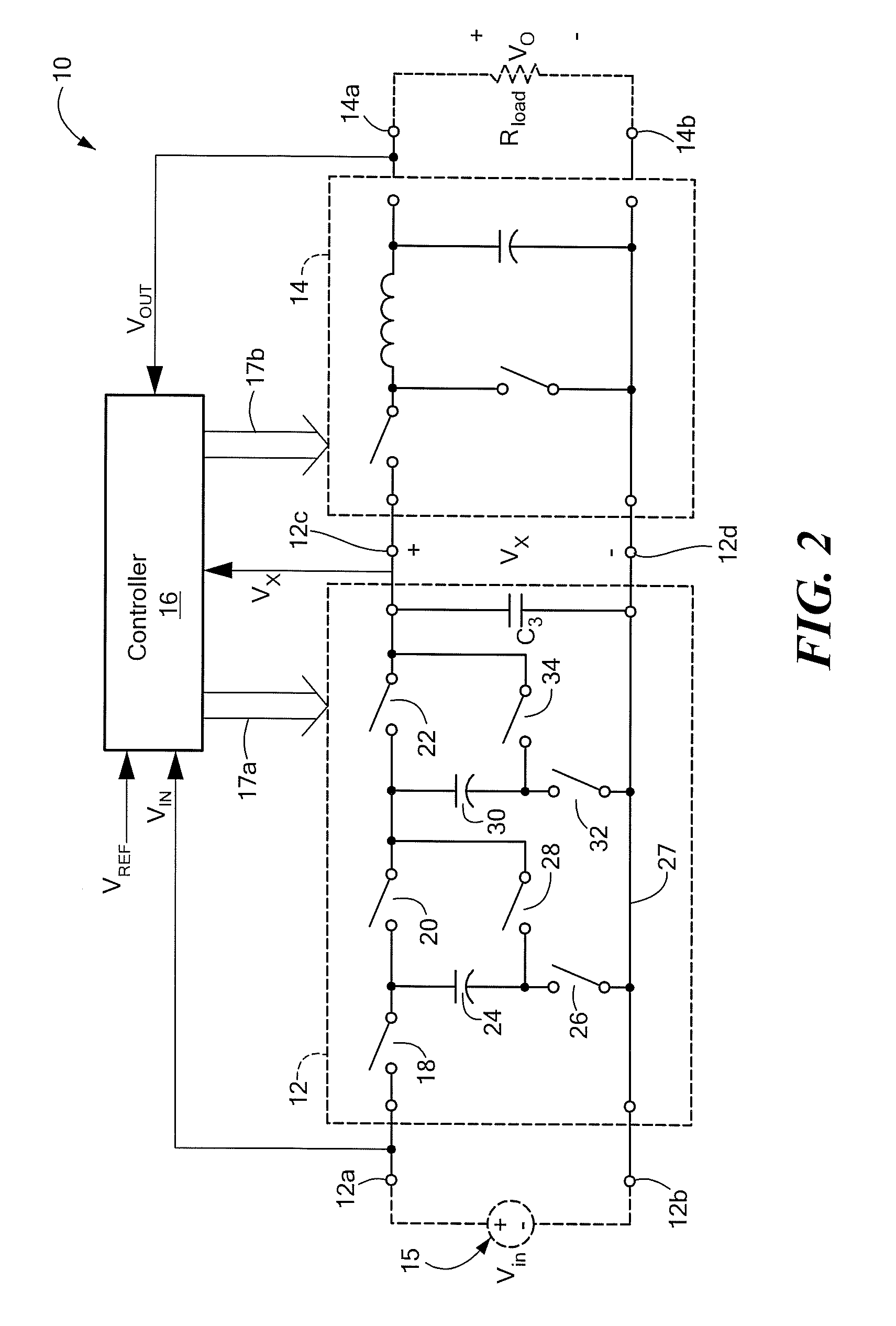[0010]A
converter circuit and related technique for providing
high power density power conversion includes a reconfigurable
switched capacitor transformation stage coupled to a magnetic converter (or regulation) stage. One objective of the circuits and techniques described herein is to provide
high power density power conversion circuits which convert an input voltage to an output voltage. In some cases, the circuit converts input voltages to output voltages which are lower than the input voltages and with a fast
transient response. In some cases, the circuits and techniques can achieve high performance over a relatively wide input
voltage range. This type of converter can be used to power logic devices in portable battery operated applications, for example, which often experience wide input voltage ranges. In other cases it may be desirable to operate the power
converter circuit so as to provide a relatively wide range of output voltages. This type of converter could be used to power digital circuits with
dynamic voltage scaling, or for supplying power to polar RF power amplifiers, for example, where wide output voltage ranges are commonly required.
[0011]Conventional (e.g. magnetic-based) power converters must typically employ
semiconductor switches that are rated for voltages similar in size to the input voltage. These relatively high-voltage blocking devices are inherently slower than lower-voltage devices, and suffer from a higher on-state resistance or larger
gate capacitance which both reduce
overall efficiency. It would thus be desirable to have a converter that provides high efficiency and fast regulation of the output over a wide input
voltage range. Such a converter that combines the strengths of the SC techniques (ease of integration, light-load performance) with the high efficiency and good regulation of conventional switched-mode power converters would be a significant improvement over conventional designs.
[0016]In another aspect, the transformation stage and regulation stage each include two or more switches. The switches in the regulation stage are selected to operate at a
switching frequency which is higher than the
switching frequency of the switches in said transformation stage. This benefits the efficiency,
power density and control bandwidth of the converter. For a given
switching frequency at small size scales, the
power density of a
switched capacitor converter can be much higher than that of a magnetic converter. Moreover, a (low-voltage) magnetic converter stage can be efficiently switched at a much higher frequency than a (high-voltage) switched
capacitor converter stage. Thus, operating the SC transformation stage at
low frequency and operating the magnetic regulation stage at
high frequency provides the best combination of
system efficiency and
power density. Moreover, as the switching frequency of the regulation stage sets the overall control bandwidth, increased frequency of the regulation stage as compared to the transformation stage enables provision of fast transient performance while maintaining high efficiency.
[0018]With this particular arrangement, a switched
capacitor converter which can provide efficient power conversion at is provided. This switched
capacitor converter may provide efficient conversion at one conversion ratio or in other designs at multiple distinct conversion ratios. The high-frequency switching converter runs at a switching frequency far higher than that of the switched-capacitor circuit and recovers the energy that is normally dissipated when charging and / or discharging the capacitors. The high-frequency switched converter can also provide high-bandwidth regulation of the converter
system output. The circuit can be configured such that the difference between the input voltage and the sum of the charging capacitor voltages appears across the input terminals of the
fast switching converter. Because this voltage is substantially lower than the switched-capacitor circuit input voltage, the auxiliary regulating converter can utilize fast, low-breakdown
semiconductor switches that enable fast operation and regulation. By making the apparent
input resistance of the auxiliary converter higher than the ESR of the switched-capacitor and the SC circuit
semiconductor switch resistances, a majority of the capacitor-charging energy can be recovered. Both of these embodiments allow for a sub 1 V dc output with high-bandwidth control of the output.
[0020]The second embodiment tightly couples a switched capacitor circuit with an auxiliary high-frequency converter (e.g. a low-voltage magnetics based converter). The high-frequency switching converter runs at a switching frequency far higher than that of the switched-capacitor circuit and recovers the energy that is normally dissipated in parasitic resistances when charging and / or discharging the capacitors. The high-frequency switched converter can also provide high-bandwidth regulation of the converter
system output. The circuit can be configured such that the difference between the input voltage and the sum of the charging capacitor voltages appears across the input terminals of the
fast switching converter. Because this voltage is substantially lower than the switched-capacitor circuit input voltage, the auxiliary regulating converter can utilize fast, low-breakdown semiconductor switches that enable fast operation and regulation. By making the apparent
input resistance of the auxiliary converter higher than the
equivalent series resistance (ESR) of the switched-capacitor and the SC circuit semiconductor switch resistances, a majority of the energy usually lost in capacitor-charging can be recovered. Both of these embodiments allow for a sub 1 V dc output with high-bandwidth control of the output.
[0023]In one embodiment, the auxiliary converter recovers energy normally dissipated when charging capacitors in said switched capacitor circuit by absorbing an instantaneous difference between stacked capacitor voltages in said switched capacitor circuit and an input voltage or an output voltage of the power converter circuit.
 Login to View More
Login to View More  Login to View More
Login to View More 


